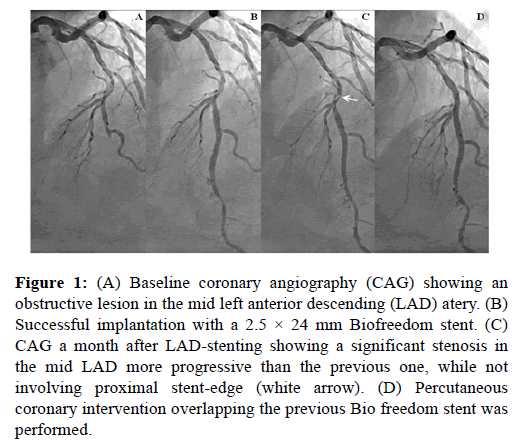Case Report - Current Trends in Cardiology (2018) Volume 2, Issue 1
Observation of early strut coverage after polymer-free biolimus-a9 coated stent by optical frequency domain imaging
Yusuke Ochiumi* and Yoriyasu Suzuki
Department of Cardiology, Nagoya Heart Center, Aichi, Japan
- *Corresponding Author:
- Yusuke Ochiumi, MD
Department of Cardiology
Nagoya Heart Center, Nagoya, Japan
Tel: +81 052 719 0810
Fax: +81 052 719 0819
Email: ub034968@yahoo.co.jp
Accepted on April 12, 2018
Abstract
An 80-year-old male patient with an acute myocardial infarction in the mid left anterior descending
artery was treated with a BioFreedom stent (2.5 × 24 mm). A month later, the patient was re-admitted
with chest pain. A significant coronary artery stenosis in the mid left anterior descending artery more
progressive than the previous one (not involving proximal stent-edge) was treated with percutaneous
coronary intervention. Then, optical frequency domain imaging of the Biofreedom stent revealed a
fully expanded stent with complete stent apposition in its entire length and strut coverage with
neointimal hyperplasia.
Keywords
Polymer-free Biolimus-A9 coated stent, Optical frequency domain imaging, neointimal hyperplasia.
Introduction
Percutaneous coronary intervention (PCI) with drug-eluting stent (DES) implantation is the standard treatment strategy of coronary artery disease. However, the issue of the duration of dual antiplatelet therapy (DAPT) after DES implantation has not been fully resolved. Especially, shortened DAPT is expected in patients with high-bleeding risk based on the recent study1. In our report, which observed early strut coverage of polymer-free Biolimus-A9 coated stent (Biofreedom) (Biosensors Inc., Newport Beach, CA) by optical frequency domain imaging (OFDI), it may be considered as further evidence to support a shortened DAPT for the indication.
Case Report
An 80-year-old man (current smoker) was admitted to our facility due to sudden onset of chest pain. He had a previous history of an operation relating to gastric cancer. Given an electrocardiogram (ECG) revealed anterior ST-segment elevation and biochemically cardiac enzyme was elevated, he was diagnosed as having a myocardial infarction. He was referred for coronary angiography (CAG), which revealed the occlusion in the mid left anterior descending artery (LAD) (Figure 1A). Following a loading dose of aspirin and prasugrel, he was treated successfully with a Biofreedom stent (2.5 × 24 mm) (Figure 1B).
Figure 1: (A) Baseline coronary angiography (CAG) showing an obstructive lesion in the mid left anterior descending (LAD) atery. (B) Successful implantation with a 2.5 × 24 mm Biofreedom stent. (C) CAG a month after LAD-stenting showing a significant stenosis in the mid LAD more progressive than the previous one, while not involving proximal stent-edge (white arrow). (D) Percutaneous coronary intervention overlapping the previous Bio freedom stent was performed.
A month post-PCI, he presented with a complaint of chest pain. ECG revealed an unchanged ST-segment and there had been no interruption in DAPT. CAG showed a significant stenosis in the mid LAD more progressive than the previous one, yet did not involve the proximal stent-edge (Figure 1C). PCI overlapping the previous Biofreedom stent was performed (Figure 1D). Then, the Biofreedom stent strut coverage and culprit lesion were observed by a supplementary OFDI (Terumo Corporation, Tokyo, Japan). OFDI images on the previous Biofreedom stent revealed a fully expanded stent without malapposition and strut coverage with neointimal hyperplasia (Figure 2).
Figure 2: (A) Supplementary optical frequency domain imaging (OFDI); upper and middle rows show cross sectional ODFI images of the previous Biofreedom stented segment of the mid LAD; (A-C) Distal-mid region of the stented segment. ((D, E) mid-proximal region of the stented segment; (F) Image in enlarged and emphasized; (E) shows mature neointimal hyperplasia having high signal [white arrows]). Biofreedom stent shows a fully expanded stent without malapposition and with neointimal coverage.
Discussion
Whereas there is a bleeding risk induced by prolonged DAPT, current guidelines [1,2] suggest the implantation of DES with 3-6 months DAPT for patients with a high bleeding risk that the recommendation is based on the limited evidences. The LEADERS-FREE trial [3] showed that Biofreedom stent with a 1-month DAPT is significantly effective and safe compared with a bare-metal stent (BMS) in high bleeding risk patients [4]. The trial showed that in the high risk population the rate of bleeding was high with 7.2% of patients in spite of short source of DAPT. In our case report to support shortened DAPT, strut coverage with neointimal hyperplasia was observed by OFDI a month post-PCI with the Biofreedom stent.
In acute coronary syndromes population at high risk of bleeding, the sub-study4 demonstrated that Biofreedom stent implantation was an efficacy and a safety similar to that of current DES compared with BMS in a 1-month DAPT. Despite a course of only 1 month DAPT, the incidence of the bleeding events was similar and >20%, and the rate of severe bleeding was >9% during the 390 days follow-up. For the patients with high bleeding risk presenting with ACS, the use of BMS might no longer be recommended.
Conclusions
Biofreedom stent may be considered as a sufficiently effective device with shortened DAPT for high bleeding risk patients.
Conflict of Interest
The authors declare no conflicts of interest in association with the present study.
References
- Levine GN, Bates ER, Bittl JA et al. ACC/AHA Guideline Focused Update on Duration of Dual Antiplatelet Therapy in Patients with Coronary Artery Disease. Circulation.2016;134:e123-55.
- Roffi M, Patrono C, Collet JP, et al. ESC Guidelines for the management of acute coronary syndromes in patients presenting without persistent ST-segment elevation. Eur Heart J. 2016;37:267-315.
- Urban P, Abizaid A, Chevalier B, et al. Rationale and design of the LEADERS FREE trial:A randomized double-blind comparison of the BioFreedom drug-coated stent vs the Gazelle bare metal stent in patients at high bleeding risk using a short (1 month) course of dual antiplatelet therapy. Am Heart J. 2013;165:704-9.
- Naber CK, Urban P, Ong PJ, et al. Biolimus-A9 polymer-free coated stent in high bleeding risk patients with acute coronary syndrome: a Leaders Free ACS sub-study. Eur Heart J. 2017;38:961-9.

